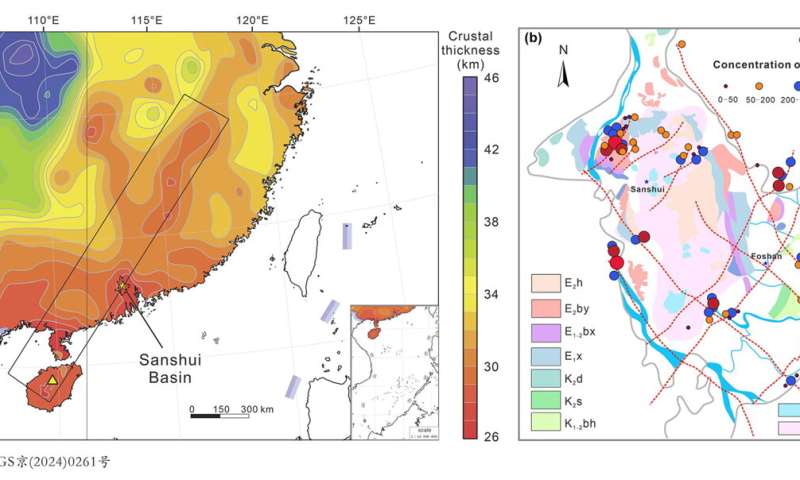Researchers discover anomalous hydrogen leakage sites in the Sanshui Basin, South China

Natural hydrogen (H2) is also known as gold H2 and is a carbon-free energy resource with potential exploitation and utilization due to its renewable, environmentally friendly, and cost-effective characteristics.
In numerous shallow depressions with circular and oval shapes, seep gases have been found with H2 concentrations of tens to more than a thousand parts per million (ppm), which highlights the potential for underground H2 resources. This has accelerated the exploration for natural H2, and many energy companies in the United States, United Kingdom, Australia, France, and Brazil have developed exploration plans.
Academician Jin Zhijun and his team discovered high-concentration H2 leakage with a maximum value of 6948 ppm in the Sanshui Basin for the first time. The related results have been published in Science Bulletin.
The Sanshui Basin is a rift basin that developed on the continental margin of South China during the Late Cretaceous to Miocene. The lithosphere beneath the basin is the thinnest in mainland China. Jin and his team conducted extensive fieldwork, and soil-gas measurements and sampling with portable gas analyzers for H2, CO2, and Rn in the Sanshui Basin.
The results show that anomalously high concentrations of H2 occur in multiple fault zones, with high 222Rn and CO2 anomalies. The chemical and H–C isotopic compositions of the soil gas were determined in the laboratory. Jin considered that the H2 concentration anomalies in the soil gas reflect seepage of H2 from deep levels.
Based on the geological context and geochemical features of soil gas in the Sanshui Basin, he proposed the detected H2 may be related to magmatic degassing, serpentinization and thermal degradation. Deep extensional faults and small faults distributed along the main faults in the basin are ideal channels for H2 ascent. The small size of the H2 molecule enables rapid diffusion.
To find economic H2 reservoirs, favorable storage conditions are crucial. Salt formation with an overall thickness of 70–120 m in the Sanshui Basin are located in the third member of the Paleogene Buxin Formation. He speculated that the low-porosity and low-permeability, dense salt rocks in the Buxin Formation of the Sanshui Basin may be a high-quality cap rock for H2 accumulation.
Jin proposed a source–transport–capture model to guide H2 exploration, which includes the three critical elements for a H2 accumulation system: sources that generate H2; faults that connect H2 sources; and traps that accumulate H2. He speculated seepage of high concentrations of H2 in the Sanshui Basin may indicate the existence of a vast accumulation or a continuous source of H2.
Therefore, the traps in the Sanshui Basin, which are connected to deep faults and covered by salt cap rocks, are likely favorable locations for H2 accumulation and exploration. In addition, he proposed that rift basins that have experienced mantle upwelling and crustal thinning, such as the Bohai Bay, Songliao, Sanshui, and Subei basins, are favorable areas for H2 exploration.
More information:
Zhijun Jin et al, Discovery of anomalous hydrogen leakage sites in the Sanshui Basin, South China, Science Bulletin (2024). DOI: 10.1016/j.scib.2024.03.002
Provided by Science China Press